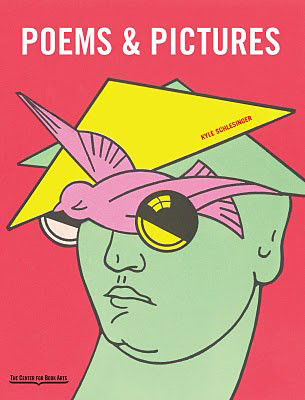Poems & Pictures now

The focus of the Poems & Pictures exhibition I curated in 2010 for the Center for Book Arts in New York City was primarily on collaborations between visual artists and poets, primarily in book form, between 1946 and 1981. I fondly refer to these thirty-five years as a ‘renaissance’ in the art of collaboration, a rich period of revitalization that was often made possible by adventurous publishers who, in various ways, made such collaborations and ways of exploring and complicating the relationship between word and image possible. The history of the book often sidesteps art history and criticism, while a close examination of the work itself tells another story, its own story, distinct, but not dissociated from other artistic and literary traditions. In these years, arguably for the first time, Americans created the first books that broke from the principles of European book design, while rivaling the experimental works of the Dadists, Futurists, and Surrealists of the early decades of the twentieth century. Some of the books included in this exhibition were: Joe Brainard’s C Comics; Wallace Berman’s Semina; Robert Duncan & Jess’ Caesar’s Gate; Tom Raworth & Jim Dine’s Big Green Day; Larry Eigner & Harry Callahan’s On My Eyes, Kenneth Patchen’s Panels for the Walls of Heaven; Ted Greenwald & Richard Bosman’s Exit the Face; Charles Bernstein & Susan Bee’s The Occurrence of Tune; Bill Berkson & Philip Guston’s Enigma Variations; Joanne Kyger & Gordon Baldwin’s Trip Out & Fall Back; and various collaborations between Ron Padgett & George Schneeman. And a whole lot more.
The exhibition also included a few books produced more recently that signal a new generation of experimental book design, as well as collaborations between poets and visual artists, is emerging. After the closing in New York, the show traveled to the Museum for Printing History in Houston, the Western New York Book Arts Center in Buffalo, and to the Center for Book and Paper Arts at Columbia College in Chicago, where it closed a few weeks ago. When I toured the exhibit around the time AWP was happening, I became increasingly aware of how many books produced post-2000 could have or should been included. The relationship between writers and artists has changed a great deal in the last thirty years, which is the primary reason Poems & Pictures ends in 1981. There are a lot of reasons for this shift, many of which were explored at the Collaborations Conference in Caen last spring, but I feel that the desire to collaborate isn’t dead, it’s just momentarily confused. In fact, the subject of collaboration in art and interactive media has never been a more mainstream topic of conversation, to say nothing of the extensive (expensive) research being produced behind the scenes at campuses and startups everywhere. One of the common distinctions between new media and old is that where mass media talks at us, new media demands that we talk back: you simply can’t just sit and watch.
Poetry has been saying the same thing for a long time, as have books that challenge traditional notions of what a book is and does, books that demand a similar form of attention, interaction and response in order to generate meaning. The relationship between the book’s makers and readers is direct, and here I’m thinking of our most carefully-conceived ebooks and books alike. For the next couple of weeks I’ll be writing about some of the writers, publishers and artists that appeared in the post-2000 section of the Poems & Pictures exhibit, as well as some others that I would like to add to this virtual curitorial project here at Jacket2.
—KS
Book arts